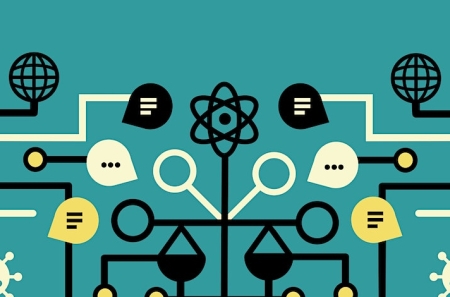
Watch Climate Change and Land in Ireland
12 April 2021In the fourth in this series of Climate Conversations, Dr Eamon Haughey discussed the challenges in the land system and the role land can play in climate mitigation and adaptation in Ireland.
Climate Conversations
This lunchtime webinar series organised by the RIA Climate Change and Environmental Sciences Committee in collaboration with the EPA provides policy-makers and key stakeholders an opportunity to engage with recently published research on climate change in Ireland, addressing the causes and consequences of climate change as well as availing of the opportunities that arise from the social and economic transition and transformation that is required.
Climate Change and Land in Ireland
The IPCC’s Special Report on Climate Change and Land was approved by governments in August 2019. This report clearly indicated that, through sustainable management, land can be an important part of the solution to climate change, but land cannot do it all. The report was particularly relevant for Ireland, which faces specific challenges in relation to climate change mitigation and adaptation in relation to land and land use. The EPA funded Climate Change and Land Use in Ireland project translated key findings from the IPCC Land Report into an Irish context. The report found that the land system in Ireland poses significant challenges to climate change mitigation goals. These challenges include a proportionally large share of greenhouse gas (GHG) emissions from the agriculture sector, a relatively low proportion of forestry cover as well as the degraded state of peatlands which store significant amounts of carbon. As part of its assessment this project also investigated the potential to implement integrated response options in Ireland. Such options have the potential to address multiple climate change challenges in the land system simultaneously. Overall, this report indicates that although the land system in Ireland is a significant contributor to national GHG emissions, it also has the potential to play an increasingly important role in climate mitigation and adaption.
In the fourth in this series of Climate Conversations, Dr Eamon Haughey gave brief presentation on this topic which can be viewed above. The presentation was followed by a Q&A session chaired by Climate Change and Environmental Sciences Committee member, Dr Olga Grant.
Q1. The issue of measuring, reporting and verifying emissions from land is difficult (compared to energy emissions). How could this be addressed?
This is a big challenge. The production of land use maps would allow researchers get a grip on how emissions might be spread across different land uses. Peatlands and soil carbon will be particularly tricky. However, there is good data from measurement of emissions from livestock sector.
It is also difficult to measure the value and impact of different response options; it requires a holistic approach.
Q2. Were options listed in order of impact e.g., low, moderate, and high potential?
The 40 options explored in the study were divided in categories and areas they would apply to. For a lot of the options there was quite limited data. Increasing soil carbon sequestration in mineral soils is only moderate due to the relatively high soil carbon levels already contained in these soils in Ireland. However, peatlands have the potential to sequester carbon for millennia.
On agri-land management there is a lot of data. A key question however is what impact dietary change could have on national GHG emissions. Reduced food waste is also a persistent problem.
Q3. What is the capacity of land in Ireland to deal with on-going climate change? Will grasslands still be possible with changing temperatures, lower/increased rainfall, etc in 20 years’ time?
The adaptation side is less developed in the literature and this gap was also brought out in workshops. It is unlikely that grassland production will be unfeasible under the medium climate change scenarios. There has been work done on alternative grassland swards. There could however be an impact of warmer temperature on carbon in soils. There is no doubt that we will need to adapt.
Q4. What about extreme events such as prolonged winter cold weather and/or droughts which hit grass production. Is that an area we need to look at more closely?
There are options for bringing more diversity and resistance to grassland swards. Crop production and irrigation are possible, but would we have the water resources to manage grasslands in droughts? There is a need to pull together an assessment of research gaps.
Q5. To what extent do we need to destock to achieve carbon reduction?
It is difficult to put a number on it. There is some work on moving marginal grasslands to production of bioenergy crops/biomethane production. In terms of changes, livestock management is a broad category e.g., improved genetics, etc. but there could be a rebound effect of increased consumption. Without a cap on the overall level of production, it is difficult. However, not incentivising efficiency is not good policy either.
The conversion of larger areas of marginal land to forestry will have social consequences in terms of acceptance. These problems are not unique to Ireland, but we should not underestimate the social side of this.
Q6. Improved genetics might actually increase intensification and go backwards in terms of emissions?
There are other things we can do in terms of diversification e.g., agroforestry might provide a way to get us out of the negative cycle.
Q7. What does diversification look like in practice?
We are talking about mixed systems e.g., crop and livestock. Another option is smaller scale horticulture and vegetable production; Ireland imports a lot of vegetables. However, farmers might be averse to these options and there are risks involved. Off-farm employment combined with an existing farm practice might be easier.
There are other things like integrating small forestry areas on farms. However, the forestry sector might prefer larger scale planting.
Q8. The issue of negative emissions is important, but it is hard to identify what parts of the land system might be credited. What work needs to be done at national and international level on this?
I agree. For example, we don’t have good data on carbon uptake for agro-forestry.
Q9. We hear a lot of concern that we are over-promising about what land can deliver and achieve in terms of carbon uptake. To what extent is it feasible or appropriate to sectorise this? What about incentivising voluntary trading?
Ireland has a challenging land system with ruminant livestock dominating. There is a lot of potential to do more with organic soils e.g., what is the condition of peatlands converted to agri use in the past and how can these be managed to make gains in terms of carbon uptake? There are issues with sectorising e.g., what if a farmer was to have some forestry on the land? There is the perennial issue of not being able to quantify things e.g., hedgerows, etc. There are plans to increase the monitoring of soil carbon on grassland.
Q10. What is the role of peatland for carbon sequestration in a changing climate?
The impact peatlands have is significant. It can be a positive impact. It is a concern that if we are having more extreme weather there might be carbon loss from peatlands. The best that we can hope for is to limit global warming to avoid loss and this is included in the IPCC reports. Re-wetting degraded peatlands might stop carbon loss (rather than create a sink for carbon). Re-wetting is going to cost a lot and there is a need to engage local communities.
There are a couple of programmes looking at the rewetting of peatlands in Ireland and Europe. The carbon connects programme is looking at this. https://www.nweurope.eu/projects/project-search/cconnects-carbon-connects/ https://lit.ie/Research-Development/Development/Climate-Action/Carbon-ConnectS-INTEREG,-North-West-Europe
Q11. Are GHG reductions possible without herd reductions?
More efficiency will reduce the intensity of emissions. Feed supplements might be a game changer but there is a lot of uncertainty about those supplements. Maybe a better way to look at it would be to ask where we could be in terms of a more diverse and profitable agricultural system e.g., beef farmers struggle to make a living. The focus on herd culling is adversarial and unhelpful.
Q12 Are there innovative ways around the data lacuna on carbon and land to get robust numbers e.g., self-reporting?
There is a lot of potential to empower land managers from different sectors to gather data, e.g., Teagasc have gathered very detailed data on grass growth. There is also potential with visual technologies, e.g., take a photo of hedgerow and convert that to a carbon number and map areas. Integrating with advisory services might be help to get people interest in collecting and recording these things.



